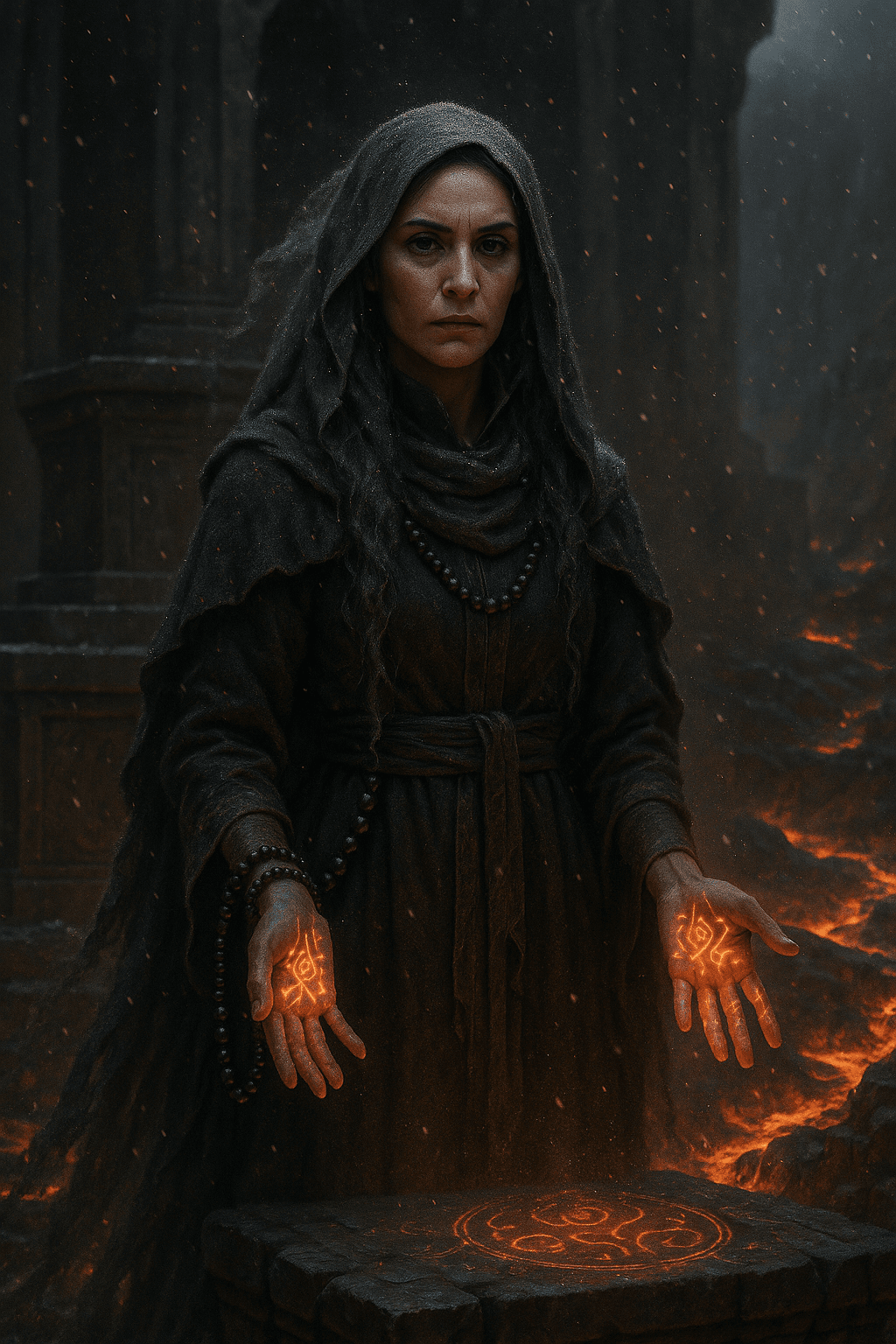Ash-Priestess Vhalra
Ritual is the leash on wildfire.

There are zealots who shout flame into being, and there are keepers who teach fire the shape of a bowl. Vhalra is the latter—an Ember Djinn wrapped in ash-lit vows, the Choir of Ember’s unyielding priestess who believes destruction must be taught its steps before it is loosed to dance. Where her prophets thunder, she whispers sigils; where her warlords charge, she prepares the crucible they will need when the heat turns back upon them.
Fracture.
When the Shattering cracked the world and birthed Thar Zûl from seams of magma, Vhalra walked out of the ash like a verdict. The Ember Choir was new then, rough with hunger and prophecy under the Inferna Prophet Kalzeth. Raiders learned quickly that fury alone could not hold a dominion together; someone had to bind the fire they worshiped. Vhalra took that as her charge.
She codified the Ember Communion—rites that mixed volcanic glass dust with blood and vow-breath, painted in spirals across warriors’ skin. “Ash remembers,” she told them, teaching that every conquest must be recorded in soot and sealed with a cooling touch, or else the land itself would spit them back. She descended into the Ash Crypts with a chain of obsidian prayer-beads and a circle of chanting acolytes, tracing fire-script along basalt ribs until the vaults answered in orange pulse. Magma-Drakes reared from their pools at her call; Ashwings learned to bank to the rhythm of her drum, smoke curling to the measure of her liturgy.
To Kalzeth she was both anchor and edge. He had vision—cities remade as kilns, enemies reduced to fuel—yet even a vision must be measured. Vhalra did not argue in public; she simply stood with ritual in her hands until impulse learned to wait. When Rorgak Ironjaw wanted to hurl whole clutches of Ashwings into an Itharûn storm just to test ash against lightning, Vhalra doused the plan with a single rite: she pressed a coal to his palm and recited the names of hatchlings not yet flown. “You do not squander what you will need for mourning,” she said, and the warlord looked away.
Her theology was practical. Fire, to Vhalra, is a contract: it consumes, and in return it grants light, heat, tempering. Break the bargain and the flame turns feral. She wrote the bargain into everything—the basalt dais where Kalzeth preached, the obsidian bridges over lava rivers, the sigils across the backs of soldiers and drakes. The Choir’s symbol, a black sun with burning tendrils, glowed steadier when she set the rites; the dominion’s nights were cruel, but they held.
Twilight.
The Last Sky War scorched the horizon and left Thar Zûl shrunken but savage. Many who thrived on conquest faltered in the harder work of endurance. Vhalra became the dominion’s stern heartbeat. She rebuilt the circles in the Ashen Forge, reshaped the Ember Communion for grief as well as glory, and walked the border calderas alone to test the wards with her own hands. “A rite is a bridge,” she told the apprentices who followed at a distance. “It must hold even when the river rises.”
An old guard hardened around her, devout to method over spectacle. They kept ledgers of coal and blood, charted ashfall like weather, timed raids to when the lava pulsed slow. Vhalra’s voice rarely lifted; it did not need to. She sponsored new liturgies for the Magma-Drakes—cooling baths laced with mineral salts to stave off Ember-sickness, war-brands placed where heat would not split them—and forbade the sacrifice of veteran mounts to feed omens. To the Choir’s faithful she was a saint of endurance; to its hotblooded captains, an unyielding brake.
The Ash Reclamation called many into the deep vaults, where magma spirits twitched in their sleep. Vhalra traced patient circles above the chasms and spoke to the heat as to a child who has not yet learned the cost of breaking toys. When a fissure began to sing—a keening that promised either revelation or ruin—she set her palm to stone and let ash creep up her wrist like frost in reverse. “Not yet,” she whispered, and the song dimmed. It is said she left part of her fire there, a vow-burn that even now keeps the seam from widening.
Power in Thar Zûl never rests. Rorgak’s warband pressed for reckless reclamations; Vhalra insisted on rites first, conquest second. She did not win every argument. She won enough. The Choir of Ember stepped into Twilight not as a bonfire, but as a forge that still held shape. Every victory was marked; every loss was named; and in the naming, the dominion learned to survive its own heat.
There are those who claim Vhalra is cold. They mistake discipline for ice. Ash on her skin is not winter—it is memory, pressed fine and made useful. In the dim halls of the Ashen Forge her silhouette is constant: a priestess with smoke in her hair and sigils bright on her palms, measuring each new zeal by what it will cost to keep. Kalzeth dreams of awakening the fire gods. Vhalra prepares the room where such a god might be safely addressed… or bound, if the bargain fails.
